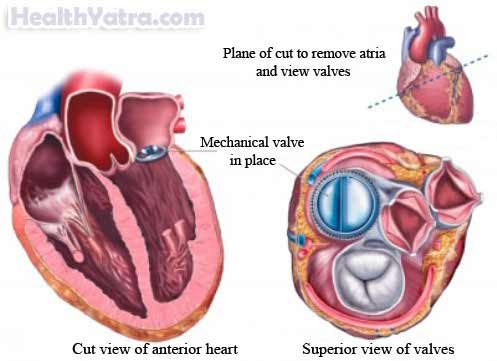সংজ্ঞা
The mitral valve is on the left side of the heart. It allows blood to flow from the left upper chamber into the left lower chamber. When the valve is not working well, it may need to be replaced.
পদ্ধতির কারণ
Healthy heart valves allow blood to flow one way. Diseased valves either leak and cause back flow or narrow and restrict flow. The condition can be life-threatening. Sometimes the valve can be repaired. Other times, it must be replaced.
Rheumatic fever, infections, defects at birth, and wear and tear are the most common causes of mitral valve problems.
সম্ভাব্য জটিলতা
If you are planning to have a mitral valve replacement, your ডাক্তার একটি তালিকা পর্যালোচনা করবে সম্ভাব্য জটিলতা, যার মধ্যে অন্তর্ভুক্ত থাকতে পারে:
- রক্তপাত
- সংক্রমণ
- Damage to the heart or other organs
- এনেস্থেশিয়ার প্রতিক্রিয়া
The demands of উন্মুক্ত হৃদপিন্ড অস্ত্রপচার are severe. The better your general health, the less likely you will experience a complication. Some of the risk factors that must be evaluated before you undergo this procedure include:
- Smoking, which can increase your risk of complications
- ডায়াবেটিস
- Weight
- হৃদরোগ
- Blood clotting disorders
- ক্যান্সার
কি আশা করা যায়
পদ্ধতির আগে
Your doctor will evaluate both your general health and the condition of your heart and circulation. Expect several heart tests, including an electrocardiogram (EKG) and anechocardiogram using ultrasound. Some patients may also have cardiac catheterization.
আপনার পদ্ধতি পর্যন্ত নেতৃত্ব:
- Talk to your doctor about your medicines, herbs, or supplements. You may be asked to stop taking some medicines up to one week before the procedure, like:
- অ্যাসপিরিন বা অন্যান্য প্রদাহ বিরোধী ওষুধ
- Blood-thinning medicines
- Do not eat or drink anything the night before your procedure.
এনেস্থেশিয়া
You will have a general anesthetic. You will be asleep.
পদ্ধতির বর্ণনা
An incision will be made along the length of your breast bone. The breast bone will be split lengthwise to expose your heart. You will then be put on a heart-lung machine. This machine takes over the work of your heart so that the doctor can stop your heart.
Your heart will be opened. A substitute valve will be sewn into place. This valve may be mechanical (metal and plastic), such as a St. Jude valve, or it may be made of tissue. Tissue valves most often come from a pig or a cow. Tissue valves may also be supplied by a human donor or even manufactured from your own tissues. When the valve is in place, you will be taken off of the heart-lung machine and your heart will be re-started. The incision will be closed.

Newer techniques, including robot-assisted procedures, are being developed. These procedures will be able to do the same surgery with smaller incisions.
অবিলম্বে প্রক্রিয়া পরে
You will be taken to a recovery room. You will be monitored for any negative reactions.
কতক্ষণ এটা লাগবে?
প্রায় 2-5 ঘন্টা
এটা কতটা আঘাত করবে?
Anesthesia will block pain during the surgery. Your chest and back will be sore following the surgery. Talk to your doctor about medicine to help manage pain.
গড় হাসপাতালে থাকার
The usual length of stay is 8-10 days. Your doctor may choose to keep you longer if complications arise.
পোস্টোপারেটিভ কেয়ার
হাসপাতালে
You will probably spend 1-3 days in the intensive care unit (ICU) and several more days in a regular hospital room. During this time, your care team will:
- Observe you for any complications
- Stabilize your heart function
- Instruct you in home care and activities
ঘরে
Be sure to follow your doctor’s instructions, which may include:
- If you have a mechanical valve, you will need to take blood thinners for life. This will help to prevent blood clots. If you have a tissue valve, you will need to take blood-thinning medicine for six weeks to three months after surgery.
- You may also need to take antibiotics during dental procedures and during certain other procedures. This will help prevent a valve infection.
- কখন গোসল করা, গোসল করা বা জলে ভিজানো নিরাপদ সে সম্পর্কে আপনার ডাক্তারকে জিজ্ঞাসা করুন।
- You will slowly return to your usual activities over a 4-12 week period. You may also be asked to participate in a cardiac rehabilitation program.
Mechanical valves can last a lifetime. Tissue valves last 7-14 years and then must be replaced. If your valve is repaired and you have no complications, you will likely do well and be able to return to normal activities.
আপনার ডাক্তারকে কল করুন
আপনি হাসপাতাল ছেড়ে যাওয়ার পরে, নিম্নলিখিতগুলির মধ্যে যেকোনটি ঘটলে আপনার ডাক্তারের সাথে যোগাযোগ করুন:
- জ্বর এবং ঠাণ্ডা সহ সংক্রমণের লক্ষণ
- লালভাব, ফোলাভাব, ক্রমবর্ধমান ব্যথা, অত্যধিক রক্তপাত, বা ছেদ স্থান থেকে কোনো স্রাব
- Constipation, diarrhea, bloody or tarry-color bowel movements, or stomach pain
- Weight gain—greater than two pounds in two days
- Worsening of ankle swelling
- আপনি আপনার স্বাগত ধন্যবাদ
- বমি বমি ভাব এবং/অথবা বমি
- কাশি, শ্বাসকষ্ট বা বুকে ব্যথা
- রক্ত কাশি
- Skin rash, or unusual bruising or bleeding
- বিভ্রান্তি
- Lightheadedness when standing
- Tingling in hands and feet
- Irregular heartbeat, extremely slow pulse, or fast pulse
- Redness, swelling, or pain in one or both legs
- Burning during urination
জরুরী পরিস্থিতিতে, অবিলম্বে চিকিৎসা সহায়তার জন্য কল করুন।
